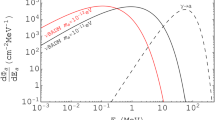Abstract
We propose a new method to detect observational appearance of dark matter axions. The method utilizes radio observations of neutron stars. It is based on the conversion of axions to photons in strong magnetic fields of neutron stars (the Primakoff effect). If the conversion occurs, the radio spectrum of the object has a very distinctive feature—a narrow spike at the frequency corresponding to the rest mass of the axion. For example, if the coupling constant of the photon-axion interaction is M = 1010 GeV, the density of dark matter axions is ρ = 10−24 g cm−3 and the axion mass is 5 μeV; then the flux from a strongly magnetized (1014 G) neutron star at the distance 300 pc from the Sun is expected to be about few tenths of millijansky at a frequency of about 1200 MHz in a bandwidth of about 3 MHz. Close-by X-ray dim isolated neutron stars are proposed as good candidates to look for such radio emission.
Similar content being viewed by others
References
P. J. E. Peebles, Int. J. Mod. Phys. A 16, 4223 (2001).
M. Kamionkowski, submitted for publication in Visions of Discovery (in Honor of Charles Townes), to be published by Cambridge University; arXiv:0706.2986.
R. D. Peccei and H. R. Quinn, Phys. Rev. D: Part. Fields 16, 1791 (1977).
H. Primakoff, Phys. Rev. 81, 899 (1951).
C. Eleftheriadis et al. (CAST Collab.) arXiv:astroph/ 0305534v1.
Y. Inoue, T. Namba, S. Moriyama, M. Minowa, Y. Takasu, T. Horiuchi, and A. Yamamoto, Phys. Lett. B 536, 18 (2002).
K. Zioutas, D. J. Thompson, and E. A. Paschos, Phys. Lett. B 443, 201 (1998).
H. Davoudiasl and P. Huber, Phys. Rev. Lett. 97, 141 302 (2006).
L. Duffy, P. Sikivie, D. B. Tanner, S. Asztalos, C. Hagmann, D. Kinion, L. J. Rosenberg, K. van Bibber, D. Yu, and R. F. Bradley, Phys. Rev. Lett. 95, 091 304 (2005).
Yu. N. Gnedin and S. V. Krasnikov, Zh. Eksp. Teor. Fiz. 102(6), 1729 (1992) [Sov. Phys. JETP 75 (6), 933 (1992)].
Yu. N. Gnedin, Astron. Astrophys. Trans. 5, 163 (1994).
P. Sikivie, arXiv:hep-ph/0606014.
M. Yu. Khlopov, A. S. Sakharov, and D. D. Sokoloff, Nucl. Phys. B, Proc. Suppl. 72, 105 (1999).
P. Sikivie, Phys. Rev. Lett. 51, 1415 (1983).
N. Rea, S. Zane, R. Turolla, M. Lyutikov, and D. Götz, AIP Conf. Proc. 983, 292 (2008).
D. Götz, S. Mereghetti, A. Tiengo, and P. Esposito, Astron. Astrophys. 449, L31 (2006).
P. Goldreich and W. H. Julian, Astrophys. J. 157, 869 (1969).
S. B. Popov, Phys. Part. Nucl. 39, 1130 (2008); arXiv:astro-ph/0610593.
B. Posselt, S. B. Popov, F. Haberl, J. Truemper, R. Turolla, and R. Neuhaeuser, Astrophys. Space Sci. 306, 171 (2007).
M. H. van Kerkwijk and D. L. Kaplan, Astrophys. J. 673, L163 (2008).
M. Lyutikov, arXiv:0708.1024.
I. Goldman and S. Nussinov, Phys. Rev. D: Part. Fields 40, 3221 (1989).
V. I. Kondratiev, M. Burgay, A. Possenti, M. A. McLaughlin, D. R. Lorimer, R. Turolla, S. Popov, and S. Zane, arXiv:0710.1648.
V. M. Malofeev, O. I. Malov, and D. A. Teplykh, Astrophys. Space Sci. 308, 211 (2007).
B. C. Joshi et al., poster at COSPAR-2008 (work in progress).
B. W. Stappers, A. G. J. van Leeuwen, M. Kramer, M. Kramer, D. Stinebring, and J. Hessels, arXiv:astroph/0701229.
Author information
Authors and Affiliations
Corresponding author
Additional information
The article is published in the original.
Rights and permissions
About this article
Cite this article
Pshirkov, M.S., Popov, S.B. Conversion of dark matter axions to photons in magnetospheres of neutron stars. J. Exp. Theor. Phys. 108, 384–388 (2009). https://doi.org/10.1134/S1063776109030030
Received:
Published:
Issue Date:
DOI: https://doi.org/10.1134/S1063776109030030




